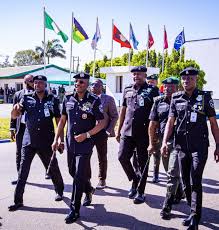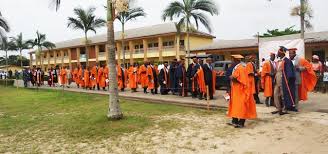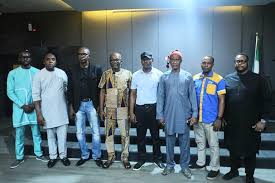Opinion
Short, Sharp, Shock-Treatment
There was a recent allusion from the Nigerian President, or the Presidency, about the possibility of some impending shock, meant to restore sanity in the country. It came as a warning to those who were alleged to be intent on destroying or destabilising Nigeria via insurgency, agitation and causing mayhem. Therefore, it has become needful to alert Nigerians about Nature’s Standing Order of Short, sharp, shock treatment (SSST), as a mechanism of restoring order when humans allow disorder to grow too high. In truth, there is such mechanism in the scheme of things.
Those who are familiar with Jewish cosmogony via the Kabbalah, would know that there is a flow of Divine influx, also known as Zazahot or lighting flash, which is an up-building and a restorative system. The 5th anchorage of that Divine Circuit system known as Geburah or Judgement has the duty or responsibility of restoring order and bringing about a balance, when disorder and imbalance become overwhelming in creation or a section thereof. Disorder and imbalances usually come from humans.
Being endowed with a free will and the freedom to make personal decisions and choices, which are often mis-used, humans bring about disorders and imbalances which distort the beauty and harmony of creation. Accumulation of massive impurities would necessitate a cleansing process to reduce the results of human engagements in acts of impunity, shamelessness and irresponsibility. Before catastrophies come there are usually warnings.
In the case of Nigeria, the warning signals have been persistent and loud enough even for obtuse persons to be aroused to a state of alertness. Nature has a process of educating human beings through bitter personal and collective experiences. No one can say that such warning signals and bitter experiences have not been there for quite some time. As a process of ensuring justice, there are watchers and weavers whose activities in the 100m of destiny entail monitoring the deeds of everyone with utmost accuracy. There are also provisions for deep reflections and possible redressing of imbalances.
Nigeria has been brought to its current sad state of affairs through many follies and deliberate acts of mischief. From Ngozi Okonjo-Iweala’s book Reforming The Unreformable, we are told that more than 5,000 board seats existed as sinecure, with political leaders having enormous patronage powers. We are told that a bad public service is certain to produce bad governance, even if the right accountability and other mechanisms are in place. Thus, there is a spiral of malfeasance.
From public service system, to tertiary education, we are told that “a systemic rot has befallen Nigeria”, apart from “inflating the budget by doubling or tripling the allocations…” Even with the Nigeria Extractive Industries Transparency Initiative (NEITI) bill which was approved in May 2007, there was no transparency or accountability in Nigeria’s oil and gas sector. In both physical and process audit there are deficiencies in management and utility.
Okonjo-Iweala advised that “special care be taken to ensure that oil revenues are spent wisely to build up durable long-term assets whose benefits can be shared with future generations”. Nigeria’s great dependence on oil and gas whose vulnerability to global volatility of commodity market are important factors in the country’s need to reshape its economic structure and growth based on diversification. With regards to corruption, Okonjo-Iweala said that “cynicism about the fight against is greatest when allegations of corrupt acts on the part of the elite are not investigated with any vigour even when investigated …”
If human verdict is reflected in the dismal and sad score card available in the public domain, then the verdict of the watchers and weavers of human destinies must also be far worse. There are indications globally that visibly gathering dark storms would surely result in some catastrophes whose true nature no one can tell accurately. For Nigeria as an individual nation in the global family, it is obvious that the shock alluded to by the President is an omen of things to come.
However, no one is in a position to predict exactly the nature and intensity of the shock the president had in mind. Reacting to the President’s statement, a number of Nigerians expressed sadness that it was a warning to agitators who allegedly are trying to destabilise and disunite Nigeria. But the situation obviously goes beyond current activities of political agitators and bandits.
Normally it takes a long time for storms to amass such power that would result in a destructive shock. Therefore, it would be myopic and wrong to judge the Nigerian situation from a one-sided perspective. Across the globe, Nigeria features as one of the delicate zones where some shocks are most likely to arise. Already harbingers of warning signals include activities of Boko Haran and other agitators for Islamic states and sharia laws, spate of kidnappings and demand for ransom, etc. The commando-rescue-style of an American farmer held hostage in Northern Nigeria placed Nigeria as a vulnerable nation.
Prelude to any coming shock usually includes complacence arising from gluttony over loots. The fact that a few highly-placed Nigerians tried to exonerate late General Sani Abacha of accusations of looting, despite exposures of such deeds, is another evidence of a nation which needs a shock to regain sanity. It takes the collaboration of humans through various activities, to serve as agents in the fulfillment of the mechanism of destiny. Such human agents rarely know that they are serving the course of Nemesis.
Unlike the Nigerian Civil War (1967-1970) with its attendant miseries and woes, SSST comes as mechanism of Divine intervention, to ensure that those who deserve to die, die the death they deserve. It is fast and thorough, with long-lasting effect. It is a weapon of sective elimination.
Dr Amirize is a retired lecturer from the Rivers State University, Port Harcourt.
Opinion
Nigeria Police And The “Miscreants” Theory

The “withdrawn” reaction of the Rivers State Police Command to public condemnation of the police antagonism to a recent peaceful protest in Port Harcourt, tagged #Take-IT-Back Movement organised by Civil Society Organisations, the Niger Delta Congress and other concerned groups, leave much to be desired. The Police Public Relations Officer of the Rivers State Command, Grace Iringe-Koko in what seems a brilliant defence to the action of the unprofessional and inordinately ambitious conduct of the policemen had described those whom the police threw cannisters of teargas at, as, “miscreants and thieves”. To say the least, the Channel Television Reporter, Charles Opurum, Allwell Ene of Naija FM, Soibelelemari Oruwari of Nigeria Info, Ikezam Godswill of AIT and Femi Ogunkhilede of Super FM who were among those tear-gassed while discharging their legitimate duties of covering the peaceful protest, could not have been “miscreants” and “thieves”. Such practice of giving people a bad name to whip up public sentiment and hate and give a cosmetic treatment to an exceedingly ugly incident, seems the antics of some men of the Nigeria Police.
Some years ago I remember a trigger- happy police officer had rhetorically asked me, “Do you know I can shoot you here and brand you a criminal”? The question that readily came to my mind was, if a public officer and a professional journalist of several years of practice could be so threatened and branded a criminal, what is the fate of common citizens in society. That lends credibility to the fact that some victims of police brutality and extra-judicial killings are innocent. They are mere victims of circumstances. It is also common experience that men of the Nigeria Police swoop on scenes of crime, arrest some innocent residents of the area, brand them suspects and hurl them in detention for more than 48 hours. Nigeria Police should be more professional enough in their operations, so that innocent people will not suffer humiliation, incarceration and financial losses for bail. Agreed that it is within the statutory obligation of the Public Relations unit to launder the image of its organisation, but it should be done with discretion, and not with utter disregard and disrespect to the sanctity of human lives. Refutal must be factual and truth based.
The public relations or image making service if not done conscientiously can dent the credibility and integrity of a practitioner. No doubt the viral video clips on the police hurling teargas cannisters on peaceful protesters cannot be described as a figment of imagination or an attempt to “incite public anxiety and create unnecessary tension within the State” as stated by the Police Public Relations Officer in her reaction to public condemnation of the action of her colleagues. Though the able and Media-friendly Rivers State Commissioner of Police has apologised to the Nigeria Union of Journalists, Rivers State Council and the assaulted Journalists, for the unprofessional conduct of the policemen who were involved in the Journalists’ brutality, the conduct was, according to the leadership of Rivers State Council of Nigeria Union of Journalists, “barbaric, inhuman and a flagrant disrespect to the rights of the assaulted journalists. Recall that the Rivers State Police Command had described as false, unfounded and baseless, reports that police officers fired teargas on unarmed protesters in an attempt to disperse them.
In the words of the Police Public Relations officer, “Upon receiving intelligence regarding the protest, our officers were promptly deployed to the specified locations. “On arrival, a group of miscreants was observed engaging in criminal acts, including the theft of mobile phones and other valuables from unsuspecting members of the public. “Our operatives responded swiftly, dispersing the individuals. This baseless story appears to be a deliberate fabrication by mischief makers seeking to incite public anxiety and create unnecessary tension within the state.” However, it is time Nigeria Police realised that the right to peaceful protest is legitimate and fundamental. It is enshrined in International rights instruments, including the Universal Declaration of Human Rights (UDHR), the International Covenant on Civil and Political Rights, the African Charter on Human and Peoples’ Rights and domesticated by Nigeria. Section 40 of Nigeria’s Constitution guarantees every citizen the right to assemble freely. The right to peaceful protest is the beauty and a function of democratic governance. It offers the masses the opportunity for self expression and calling erring or a failed government or leadership back to its statutory obligation.
It allows people to publicly voice their concerns, challenge injustices, and participate actively in the democratic process. Protests serve as a vital mechanism for holding leaders accountable and ensuring that government actions reflect the will and needs of the people. The recognition and approval of the right to protest is one action that makes a great difference between a truly democratic government from a repressive, dictatorial and despotic administration. Protest is evident and inevitable in every human institution or organisation from family to school, work places etc, if the heads or the administrators abuse their position and treat with contempt the people on whose prerogative they (leaders) were elected. Some children have also protested against their parents, students protest against wrong administration etc. Protest is therefore, a corrective mechanism, it is expression of a dissenting position against anti-people policies and programmes. The distinctiveness of the Democratic governance over the Military is unreserved and unalloyed respect and regard for the Rule of Law. If the Rule of Law and its implications are undermined, then there is inevitable transition to dictatorship, a military regime in the garb of a civilian administration.
However, the calamitous consequences during the #EndSARS protest and #EndBadGovernance protest show that the respect for the rule of law and its implications remain a far-cry to constitutional requirement. The losses incurred during such protests cannot be consigned to the dusbin of history in a hurry. What is the outcome of the #EndSARS protests and brutality? Nigeria Police and other security agencies should tread with caution on the issue of peaceful protests and treating journalists and innocent members of the public as “miscreants”, and “thieves”.
By: Igbiki Benibo
Opinion
Essence of Easter

It’s another Easter, a day Christians the world over celebrate the resurrection of Jesus Christ from death. At the heart of Easter is the belief that Jesus rose from death on the third day after His crucifixion (as described in the Gospels of Matthew, Mark, Luke, and John). This event is seen as proof that Jesus is the Son of God and that His promises of eternal life are true.The resurrection is seen as Jesus’ victory over sin, death, and the power of evil. His rising means that those who believe in Him are no longer bound by sin or spiritual death but can share in His eternal life. Easter symbolses new life, not just spiritually but in how believers live their daily lives. Just as Christ rose, Christians believe they too can rise from past mistakes, addictions, guilt, or despair, and walk in a “newness of life.” In a world full of suffering, uncertainty, and death, Easter offers hope—the assurance that pain and death do not have the final word. It reminds Christians that no matter how bad things get, there is always the possibility of resurrection, restoration, and new beginnings.
But even beyond the religious narrative, Easter coroborates¹ a universal truth: that suffering is not the end of the story, and that even in the darkest times, renewal is possible. For many Nigerians today, that message feels especially urgent. The economic situation is unbearable. The cost of living has reached painful highs. A bag of rice now costs more than many families earn in a month. Electricity remains unreliable, jobs are scarce, and the dream of a better tomorrow feels distant. Politically, many are disillusioned. Promises come and go like the harmattan wind—loud in arrival, but often empty in effect. Elections have come and gone, but the people’s cries often go unheard. The skyrocketing prices in the markets, currency fluctuations, ever-rising cost of living, unabating insecurity have become the daily realities of many Nigerians. In the past few weeks, the conflict in Plateau and Benue States have reportedly claimed several lives. Thousands of people from the affected communities have fled from their ancestral homes.
Recently, in Uzo-Uwani Local Government Area of Enugu State, about 25 people were reportedly killed, several properties destroyed by insurgents who attacked the agrarian communities. Many other communities in the country have painful stories arising from insecurity. Amid all this, Easter arrives—not merely as a date on the calendar, but as a symbol, a whisper from the heavens that says: this is not the end. As earlier stated, at the very core of Easter is a message of resurrection. For Christians, it is the story of Jesus Christ, who after the pain of the cross and the silence of the tomb, rose again in glory. But beyond the church pews and Sunday services, Easter holds a timeless message for every Nigerian: after suffering comes renewal, after darkness comes light. It reminds us that there is still power in perseverance. That in the same way Christ endured the cross and emerged victorious, we too must hold on—even if just barely—believing that change is possible. Easter calls us to resist the temptation to give in to hopelessness. It urges us to keep pushing, to keep speaking out, to keep believing that Nigeria can rise.
There’s an old Yoruba proverb that says, “Bi iku ile o ba pa ni, t’ode o le pa ni” — “If the threat at home does not kill one, that from outside cannot.” In other words, it is from within that we draw our strength. Despite economic hardship, political frustrations, feeling forgotten by those in power, we as a people should not give up. And that is the essence of Easter. The Bible says in Romans 8:18, “For I reckon that the sufferings of this present time are not worthy to be compared with the glory which shall be revealed in us.” It reminds us that hardship is not permanent. Things can change. We can rise. But Easter is not just a story of survival it is a call to action. Like Jesus’ resurrection, it demands transformation. It asks each of us: What must die in our society so that something better can live? Is it corruption? Is it apathy? Is it greed? And more personally: What must rise in us? integrity? compassion? courage?
Nelson Mandela once said, “Our human compassion binds us the one to the other—not in pity or patronisingly, but as human beings who have learnt how to turn our common suffering into hope for the future.” We must stop waiting for change from the top and start building it from the ground. Whether supporting a struggling neighbor, voting with conscience, speaking the truth in our workplaces, or simply refusing to cheat the next man—these are the small resurrections that will one day lift Nigeria from the grave. As the Igbos say, “Obu onye kwe, chi ya ekwe” — “When one agrees (to something), his spirit agrees also.” If we, the people, agree to rise—to hold onto hope and live with purpose—then even heaven will back our efforts. In a world that often feels heavy with uncertainty, conflict, and division, Easter invites us to pause and reflect. It challenges us to consider how we treat one another, how we face adversity, and whether we still believe in the possibility of transformation. It’s a moment to ask: What needs be resurrected in our own lives? Is it a lost relationship, a forgotten dream, or simply the courage to begin again?
This Easter, let us reflect deeply. Not only on the pain we have endured, but on the promise that lies ahead. Let us pray, yes—but also act. Let us hope but also build. Above all, let us remember: no matter how long the night is, the morning must surely come. Let the message of the empty tomb stir us into action—not out of fear or anger, but out of the same love and sacrifice that Easter celebrates. Because no matter how long the night, the dawn always comes.”Weeping may endure for a night, but joy cometh in the morning.” — Psalm 30:5. Happy Easter, Nigeria.
By: Calista Ezeaku
Opinion
Addressing Nigeria’s Social Ills Through Cultural Education
One of the critical problems confronting Nigeria today is the lack of recognition and appreciation of our tangible heritage, values, and norms – elements that are crucial for fostering social cohesion and responsibility. These values, which are inherently adaptive, can only be transmitted effectively through cultural education.Nigerian food Cultural education involves socialising individuals into the norms, values, and heritage of a given society through mediums such as folktales. Its primary intent is to nurture socially responsible and morally upright individuals who contribute positively to their community. In essence, cultural education is a learned behavioral pattern shared and transmitted from one generation to another. It encompasses customs, traditions, beliefs, arts, and philosophies of life. As Babs Fafunwa (1994) observed, every society, regardless of its size, has its unique ways of transmitting its cultural heritage.
Cultural education plays a vital role in shaping a child’s character and physical skills. Cultural education also has unique ways of instilling respect for elders and authority in the child. In addition, cultural education helps in developing intellectual abilities, fostering a sense of belonging, and promoting active participation in family and community affairs. This concept also cultivates a healthy attitude towards honest labour while it also helps to preserve the community’s cultural heritage. However, since Nigeria’s independence in 1960, the infiltration of foreign cultures, technological advancements, religious beliefs, and political systems have significantly helped in the erosion of the country’s social fabric. Today, Nigeria grapples with the loss of cultural values in more ways than one. The country also grapples with moral laxity among youths, violence, delinquent behaviours as well as the disruption of traditional political systems.
Beyond these, lack of cultural education has also triggered a decline in political will among the country’s citizenry. Thus, social issues such as sex abuse, prostitution, drug trafficking, kidnapping for ransom, internet fraud (which are more commonly known as 419); cybercrime, militancy, armed robbery, and examination malpractice have become rampant. However, these challenges can be mitigated through the promotion and sustenance of cultural education in Nigeria. Bringing cultural education forward in the country’s socio-political and economic systems would go a long way in redirecting the citizenry from the identified social ills. For instance, cultural socialization teaches children the proper ways to greet elders and interact respectfully. Observing parents during ceremonies are also a way to achieving this. Ceremonies such as weddings, child-naming, or funerals help children learn appropriate behaviour at such and sundry ceremonies, and decorum. Unfortunately, many youths today lack respect for elders and are antagonistic to cultural values. Instead, they are influenced by foreign films, contents and literature which often glorify disrespect to our culture; violence and weapon use. As a result, some have become political thugs, religious extremists or armed robbers. They now pose a severe threat to Nigeria’s national survival.
Furthermore, exposure to undesirable foreign cultures has led to extensive moral degradation which manifest in ways such as drug abuse, prostitution, theft, and internet fraud. Dressing among Nigerian youths is another concern. Many young people disregard their cultural heritage and show utmost disdain for their geographical environment. For example, some young women wear clothing that leaves vital parts of their bodies exposed, while young men adopt unkempt appearances, including sagging their trousers and leaving their shirts unbuttoned. There are also instances of unfastened shoelaces. These issues can be addressed through family-based cultural socialisation, where parents play a critical role in imparting cultural education. It is therefore recommended that, to address these social ills, the following measures are suggested. The first is that there should be ways to incorporate cultural education into the curriculum of our schools. Nigeria’s education system should be reviewed to emphasise cultural education, including the use of indigenous languages for instruction. Cultural elements such as morality, taboos, mores, and folktales should be promoted to shape human behaviour positively.
Another suggestion is that we should indigenise the Nigerian political systems. The political system should incorporate cultural principles and practices specific to Nigeria’s diverse cultural environments. This will encourage greater participation and accountability among political leaders. Thirdly, we must promote local content in media. A ban should be placed on the excessive use of foreign entertainment packages in media houses and on social media. Instead, Nigerian cultural content should be prioritised and promoted to reinforce cultural identity. Also, we must strengthen parental socialisation. Through this, families must embrace parental socialisation as a key method for imparting cultural education. Parents should model cultural values and behaviours to guide their children effectively. Cultural education is very essential for curbing social ills in Nigeria. By integrating it into our education system, political practices and media content, we can foster a society rooted in strong moral values and cultural heritage, thereby ensuring a strong and brighter future for generations to come.
Modupe is Chief Museum Education Officer, National Commission for Museums & Monuments, Osogbo, Osun State.
Veronica Adewole
-

 News2 days ago
News2 days agounpaid salaries: Abia teachers to begin strike Thursday
-

 Education1 day ago
Education1 day agoRivers Poly Matriculates 1, 882 Fresh Students
-

 News2 days ago
News2 days agoIAWPA Honours Rivers NSCDC Commandant
-
Niger Delta2 days ago
Tompolo, N’Delta’s Distinguished Son – Oborevwori
-

 Politics2 days ago
Politics2 days agoFG Reaffirms Commitment To Enduring Democracy
-

 News2 days ago
News2 days agoSERAP Sues NBC Over Ban On ‘Tell Your Papa’ Song
-

 Maritime1 day ago
Maritime1 day agoRacketeering: TTP Trains Customs Agents, Freight Forwarders On Eto APP
-

 News2 days ago
News2 days agoHYPREP Moves To Complete Ongoing Projects This Year

